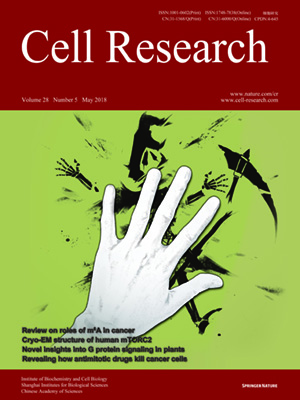
Volume 28, No 5, May 2018
ISSN: 1001-0602
EISSN: 1748-7838 2018
impact factor 17.848*
(Clarivate Analytics, 2019)
Volume 28 Issue 5, May 2018: 518-528
ORIGINAL ARTICLES
Cryo-EM structure of human mTOR complex 2
Xizi Chen 1,2,3, Mengjie Liu 1,2,3, Yuan Tian 1,2,3, Jiabei Li 1,2,3, Yilun Qi 1,2,3, Dan Zhao 1,2,3, Zihan Wu 1,2,3, Min Huang 4,Catherine C. L. Wong 4,5,6, Hong-Wei Wang 7, Jiawei Wang 7
, Huirong Yang 1,2,3 and Yanhui Xu 1,2,3,8
1Fudan University Shanghai Cancer Center, Institutes of Biomedical Sciences, Shanghai Medical College of Fudan University, Shanghai 200032, China; 2Key Laboratory of Molecular Medicine, Ministry of Education, Department of Systems Biology for Medicine, School of Basic Medical Sciences, Shanghai Medical College of Fudan University,Shanghai 200032, China; 3State Key Laboratory of Genetic Engineering, Collaborative Innovation Center of Genetics and Development, School of Life Sciences, Fudan University,Shanghai 200433, China; 4National Center for Protein Science Shanghai, Institute of Biochemistry and Cell Biology, Shanghai Institutes for Biological Sciences, Chinese Academy of Sciences, Shanghai 201210, China; 5Center for Precision Medicine Multi-Omics Research (CPMMOR), Peking University Health Science Center, Beijing 100871, China; 6 State Key Laboratory of Natural and Biomimetic Drugs, School of Pharmaceutical Science, Peking University, Beijing 100871, China; 7Ministry of Education Key Laboratory of Protein Sciences, Tsinghua-Peking Joint Center for Life Sciences, Beijing Advanced Innovation Center for Structural Biology, School of Life Sciences, Tsinghua University, Beijing 100084,China and 8CAS Center for Excellence in Molecular Cell Science, Chinese Academy of Sciences, Shanghai 200031, China
Correspondence: Huirong Yang (yanghr@fudan.edu.cn) or Yanhui Xu (xuyh@fudan.edu.cn)These authors contributed equally: Xizi Chen, Mengjie Liu In PDF, please change running title to "Cryo-EM structure of human mTORC2"
Mechanistic target of rapamycin (mTOR) complex 2 (mTORC2) plays an essential role in regulating cell proliferation through phosphorylating AGC protein kinase family members, including AKT, PKC and SGK1. The functional core complex consists of mTOR, mLST8, and two mTORC2-specific components, Rictor and mSin1. Here we investigated the intermolecular interactions within mTORC2 complex and determined its cryo-electron microscopy structure at 4.9 Å resolution. The structure reveals a hollow rhombohedral fold with a 2-fold symmetry. The dimerized mTOR serves as a scaffold for the complex assembly. The N-terminal half of Rictor is composed of helical repeat clusters and binds to mTOR through multiple contacts. mSin1 is located close to the FRB domain and catalytic cavity of mTOR. Rictor and mSin1 together generate steric hindrance to inhibit binding of FKBP12-rapamycin to mTOR, revealing the mechanism for rapamycin insensitivity of mTORC2. The mTOR dimer in mTORC2 shows more compact conformation than that of mTORC1 (rapamycin sensitive), which might result from the interaction between mTOR and Rictor-mSin1. Structural comparison shows that binding of Rictor and Raptor (mTORC1-specific component) to mTOR is mutually exclusive. Our study provides a basis for understanding the assembly of mTORC2 and a framework to further characterize the regulatory mechanism of mTORC2 pathway.
10.1038/s41422-018-0029-3
FULL TEXT | PDF
Browse 1915


